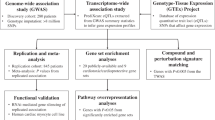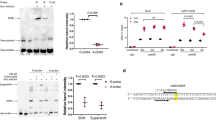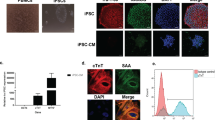Abstract
Anthracyclines are used in over 50% of childhood cancer treatment protocols1, but their clinical usefulness is limited by anthracycline-induced cardiotoxicity (ACT) manifesting as asymptomatic cardiac dysfunction and congestive heart failure in up to 57% and 16% of patients, respectively2,3. Candidate gene studies have reported genetic associations with ACT4,5,6,7,8,9,10,11,12,13,14,15,16,17,18,19,20,21,22, but these studies have in general lacked robust patient numbers, independent replication or functional validation. Thus, the individual variability in ACT susceptibility remains largely unexplained12,13. We performed a genome-wide association study in 280 patients of European ancestry treated for childhood cancer, with independent replication in similarly treated cohorts of 96 European and 80 non-European patients. We identified a nonsynonymous variant (rs2229774, p.Ser427Leu) in RARG highly associated with ACT (P = 5.9 × 10−8, odds ratio (95% confidence interval) = 4.7 (2.7–8.3)). This variant alters RARG function, leading to derepression of the key ACT genetic determinant Top2b, and provides new insight into the pathophysiology of this severe adverse drug reaction.
This is a preview of subscription content, access via your institution
Access options
Subscribe to this journal
Receive 12 print issues and online access
$209.00 per year
only $17.42 per issue
Buy this article
- Purchase on Springer Link
- Instant access to full article PDF
Prices may be subject to local taxes which are calculated during checkout


Similar content being viewed by others
References
Smith, L.A. et al. Cardiotoxicity of anthracycline agents for the treatment of cancer: systematic review and meta-analysis of randomised controlled trials. BMC Cancer 10, 337 (2010).
van der Pal, H.J. et al. Cardiac function in 5-year survivors of childhood cancer: a long-term follow-up study. Arch. Intern. Med. 170, 1247–1255 (2010).
van der Pal, H.J. et al. High risk of symptomatic cardiac events in childhood cancer survivors. J. Clin. Oncol. 30, 1429–1437 (2012).
Armenian, S.H. et al. Genetic susceptibility to anthracycline-related congestive heart failure in survivors of haematopoietic cell transplantation. Br. J. Haematol. 163, 205–213 (2013).
Blanco, J.G. et al. Genetic polymorphisms in the carbonyl reductase 3 gene CBR3 and the NAD(P)H:quinone oxidoreductase 1 gene NQO1 in patients who developed anthracycline-related congestive heart failure after childhood cancer. Cancer 112, 2789–2795 (2008).
Blanco, J.G. et al. Anthracycline-related cardiomyopathy after childhood cancer: role of polymorphisms in carbonyl reductase genes—a report from the Children’s Oncology Group. J. Clin. Oncol. 30, 1415–1421 (2012).
Lipshultz, S.E. et al. Impact of hemochromatosis gene mutations on cardiac status in doxorubicin-treated survivors of childhood high-risk leukemia. Cancer 119, 3555–3562 (2013).
Lubieniecka, J.M. et al. A discovery study of daunorubicin induced cardiotoxicity in a sample of acute myeloid leukemia patients prioritizes P450 oxidoreductase polymorphisms as a potential risk factor. Front. Genet. 4, 231 (2013).
Rajić, V. et al. Influence of the polymorphism in candidate genes on late cardiac damage in patients treated due to acute leukemia in childhood. Leuk. Lymphoma 50, 1693–1698 (2009).
Rossi, D. et al. Analysis of the host pharmacogenetic background for prediction of outcome and toxicity in diffuse large B-cell lymphoma treated with R-CHOP21. Leukemia 23, 1118–1126 (2009).
Semsei, A.F. et al. ABCC1 polymorphisms in anthracycline-induced cardiotoxicity in childhood acute lymphoblastic leukaemia. Cell Biol. Int. 36, 79–86 (2012).
Visscher, H. et al. Pharmacogenomic prediction of anthracycline-induced cardiotoxicity in children. J. Clin. Oncol. 30, 1422–1428 (2012).
Visscher, H. et al. Validation of variants in SLC28A3 and UGT1A6 as genetic markers predictive of anthracycline-induced cardiotoxicity in children. Pediatr. Blood Cancer 60, 1375–1381 (2013).
Wang, X. et al. Hyaluronan synthase 3 variant and anthracycline-related cardiomyopathy: a report from the Children’s Oncology Group. J. Clin. Oncol. 32, 647–653 (2014).
Windsor, R.E., Strauss, S.J., Kallis, C., Wood, N.E. & Whelan, J.S. Germline genetic polymorphisms may influence chemotherapy response and disease outcome in osteosarcoma: a pilot study. Cancer 118, 1856–1867 (2012).
Wojnowski, L. et al. NAD(P)H oxidase and multidrug resistance protein genetic polymorphisms are associated with doxorubicin-induced cardiotoxicity. Circulation 112, 3754–3762 (2005).
Volkan-Salanci, B. et al. The relationship between changes in functional cardiac parameters following anthracycline therapy and carbonyl reductase 3 and glutathione S transferase Pi polymorphisms. J. Chemother. 24, 285–291 (2012).
Lubieniecka, J.M. et al. Single-nucleotide polymorphisms in aldo-keto and carbonyl reductase genes are not associated with acute cardiotoxicity after daunorubicin chemotherapy. Cancer Epidemiol. Biomarkers Prev. 21, 2118–2120 (2012).
Cascales, A. et al. Association of anthracycline-related cardiac histological lesions with NADPH oxidase functional polymorphisms. Oncologist 18, 446–453 (2013).
Cascales, A. et al. Clinical and genetic determinants of anthracycline-induced cardiac iron accumulation. Int. J. Cardiol. 154, 282–286 (2012).
Vivenza, D. et al. Role of the renin-angiotensin-aldosterone system and the glutathione S-transferase Mu, Pi and Theta gene polymorphisms in cardiotoxicity after anthracycline chemotherapy for breast carcinoma. Int. J. Biol. Markers 28, e336–e347 (2013).
Sachidanandam, K., Gayle, A.A., Robins, H.I. & Kolesar, J.M. Unexpected doxorubicin-mediated cardiotoxicity in sisters: possible role of polymorphisms in histamine N-methyl transferase. J. Oncol. Pharm. Pract. 19, 269–272 (2013).
Krischer, J.P. et al. Clinical cardiotoxicity following anthracycline treatment for childhood cancer: the Pediatric Oncology Group experience. J. Clin. Oncol. 15, 1544–1552 (1997).
Hasan, S., Dinh, K., Lombardo, F. & Kark, J. Doxorubicin cardiotoxicity in African Americans. J. Natl. Med. Assoc. 96, 196–199 (2004).
Hershman, D. et al. Racial disparities in treatment and survival among women with early-stage breast cancer. J. Clin. Oncol. 23, 6639–6646 (2005).
Duan, S. et al. Mapping genes that contribute to daunorubicin-induced cytotoxicity. Cancer Res. 67, 5425–5433 (2007).
Peters, E.J. et al. Pharmacogenomic characterization of US FDA-approved cytotoxic drugs. Pharmacogenomics 12, 1407–1415 (2011).
Lipshultz, S.E., Alvarez, J.A. & Scully, R.E. Anthracycline associated cardiotoxicity in survivors of childhood cancer. Heart 94, 525–533 (2008).
Barry, E., Alvarez, J.A., Scully, R.E., Miller, T.L. & Lipshultz, S.E. Anthracycline-induced cardiotoxicity: course, pathophysiology, prevention and management. Expert Opin. Pharmacother. 8, 1039–1058 (2007).
Agarwala, S. et al. High incidence of adriamycin cardiotoxicity in children even at low cumulative doses: role of radionuclide cardiac angiography. J. Pediatr. Surg. 35, 1786–1789 (2000).
Shaikh, A.S., Saleem, A.F., Mohsin, S.S., Alam, M.M. & Ahmed, M.A. Anthracycline-induced cardiotoxicity: prospective cohort study from Pakistan. BMJ Open 3, e003663 (2013).
Chambon, P. A decade of molecular biology of retinoic acid receptors. FASEB J. 10, 940–954 (1996).
Tang, Q. et al. A comprehensive view of nuclear receptor cancer cistromes. Cancer Res. 71, 6940–6947 (2011).
Minotti, G., Menna, P., Salvatorelli, E., Cairo, G. & Gianni, L. Anthracyclines: molecular advances and pharmacologic developments in antitumor activity and cardiotoxicity. Pharmacol. Rev. 56, 185–229 (2004).
Zhang, S. et al. Identification of the molecular basis of doxorubicin-induced cardiotoxicity. Nat. Med. 18, 1639–1642 (2012).
Lyu, Y.L. et al. Topoisomerase IIβ mediated DNA double-strand breaks: implications in doxorubicin cardiotoxicity and prevention by dexrazoxane. Cancer Res. 67, 8839–8846 (2007).
Bilbija, D. et al. Retinoic acid signalling is activated in the postischemic heart and may influence remodelling. PLoS ONE 7, e44740 (2012).
Delacroix, L. et al. Cell-specific interaction of retinoic acid receptors with target genes in mouse embryonic fibroblasts and embryonic stem cells. Mol. Cell. Biol. 30, 231–244 (2010).
Wheeler, H.E., Maitland, M.L., Dolan, M.E., Cox, N.J. & Ratain, M.J. Cancer pharmacogenomics: strategies and challenges. Nat. Rev. Genet. 14, 23–34 (2013).
McLeod, H.L. Cancer pharmacogenomics: early promise, but concerted effort needed. Science 339, 1563–1566 (2013).
Nelson, M.R. et al. Genome-wide approaches to identify pharmacogenetic contributions to adverse drug reactions. Pharmacogenomics J. 9, 23–33 (2009).
Ortega, J.J. et al. Treatment with all-trans retinoic acid and anthracycline monochemotherapy for children with acute promyelocytic leukemia: a multicenter study by the PETHEMA Group. J. Clin. Oncol. 23, 7632–7640 (2005).
Pellicori, P., Calicchia, A., Lococo, F., Cimino, G. & Torromeo, C. Subclinical anthracycline cardiotoxicity in patients with acute promyelocytic leukemia in long-term remission after the AIDA protocol. Congest. Heart Fail. 18, 217–221 (2012).
Arima, K. et al. Global analysis of RAR-responsive genes in the Xenopus neurula using cDNA microarrays. Dev. Dyn. 232, 414–431 (2005).
Palm-Leis, A. et al. Mitogen-activated protein kinases and mitogen-activated protein kinase phosphatases mediate the inhibitory effects of all-trans retinoic acid on the hypertrophic growth of cardiomyocytes. J. Biol. Chem. 279, 54905–54917 (2004).
Simandi, Z., Balint, B.L., Poliska, S., Ruhl, R. & Nagy, L. Activation of retinoic acid receptor signaling coordinates lineage commitment of spontaneously differentiating mouse embryonic stem cells in embryoid bodies. FEBS Lett. 584, 3123–3130 (2010).
Welter, D. et al. The NHGRI GWAS Catalog, a curated resource of SNP-trait associations. Nucleic Acids Res. 42, D1001–D1006 (2014).
Rodvold, K.A., Rushing, D.A. & Tewksbury, D.A. Doxorubicin clearance in the obese. J. Clin. Oncol. 6, 1321–1327 (1988).
Kremer, L.C., van Dalen, E.C., Offringa, M., Ottenkamp, J. & Voute, P.A. Anthracycline-induced clinical heart failure in a cohort of 607 children: long-term follow-up study. J. Clin. Oncol. 19, 191–196 (2001).
Lipshultz, S.E. et al. Late cardiac effects of doxorubicin therapy for acute lymphoblastic leukemia in childhood. N. Engl. J. Med. 324, 808–815 (1991).
Lipshultz, S.E. et al. Female sex and drug dose as risk factors for late cardiotoxic effects of doxorubicin therapy for childhood cancer. N. Engl. J. Med. 332, 1738–1743 (1995).
Altman, A.J. in Supportive Care of Children with Cancer: Current Therapy and Guidelines from the Children’s Oncology Group 3rd edn. (ed. Lacuone, J.) 139–148 (John Hopkins University Press, 2004).
Mulrooney, D.A. et al. Cardiac outcomes in a cohort of adult survivors of childhood and adolescent cancer: retrospective analysis of the Childhood Cancer Survivor Study cohort. Br. Med. J. 339, b4606 (2009).
Visscher, H. et al. Genetic variants in SLC22A17 and SLC22A7 are associated with anthracycline-induced cardiotoxicity in children. Pharmacogenomics (in the press).
Barrett, J.C., Fry, B., Maller, J. & Daly, M.J. Haploview: analysis and visualization of LD and haplotype maps. Bioinformatics 21, 263–265 (2005).
Pruim, R.J. et al. LocusZoom: regional visualization of genome-wide association scan results. Bioinformatics 26, 2336–2337 (2010).
Browning, S.R. & Browning, B.L. Rapid and accurate haplotype phasing and missing-data inference for whole-genome association studies by use of localized haplotype clustering. Am. J. Hum. Genet. 81, 1084–1097 (2007).
Visscher, H. et al. Application of principal component analysis to pharmacogenomic studies in Canada. Pharmacogenomics J. 9, 362–372 (2009).
Devlin, B. & Roeder, K. Genomic control for association studies. Biometrics 55, 997–1004 (1999).
Acknowledgements
We acknowledge the participation of all the patients and families who took part in this study across Canada, the Netherlands and the United States. This work was supported by the Canadian Institutes of Health Research (CIHR; FRN-88362 to B.C.C., M.R.H. and C.J.D.R.), the CIHR Drug Safety and Effectiveness Network (FRN-117588 to B.C.C. and C.J.D.R.), the US National Institutes of Health (1R21HL123655-01 and HL123655 to D.B., B.C.C. and C.J.D.R.), a Stanford Comprehensive Cancer Center Translation Research Grant (to D.B.), the Child & Family Research Institute (Vancouver, British Columbia, Canada; Bertram Hoffmeister Postdoctoral Fellowship Award for F.A.), the Michael Smith Foundation for Health Research (Postdoctoral Fellowship Award for F.A.), the CIHR Training Program in Bridging Scientific Domains for Drug Safety and Effectiveness–DSECT program (Postdoctoral Fellowship Award for F.A.), the Canada Foundation for Innovation, Genome British Columbia and the Provincial Health Service Authority. Additional funding was provided by the Child & Family Research Institute (Vancouver, British Columbia, Canada), the Faculty of Medicine of the University of British Columbia, the Canadian Gene Cure Foundation, the C17 Research Network and the Childhood Cancer Foundation–Candlelighters Canada.
Author information
Authors and Affiliations
Consortia
Contributions
B.C.C., M.R.H. and C.J.D.R. conceived and supervised the study. F.A., H.V., S.R.R., H.N.C., E.C.v.D., L.C.K., H.J.v.d.P., D.B., C.J.D.R., B.C.C. and the CPNDS Consortium enrolled the patients and collected and interpreted clinical data. F.A. conceived the statistical analyses, and F.A., H.V., J.W.L., A.P.B. and C.J.D.R. performed the statistical analyses. A.P.B. conceived the experiments, and A.P.B. and Y.L. performed the experiments. F.A., A.P.B., H.V., S.R.R., J.W.L., L.R.B., U.A., H.N.C., L.C.K., E.C.v.D., H.J.v.d.P., M.J.R., D.B., B.C.C., M.R.H. and C.J.D.R. analyzed and interpreted the data. All authors contributed to the writing, review and approval of the manuscript.
Corresponding author
Ethics declarations
Competing interests
M.R.H., B.C.C., C.J.D.R., F.A., H.V. and A.P.B. have filed provisional patents based on the results of this work (US provisional patents 62/077,702 and 62/135,351).
Integrated supplementary information
Supplementary Figure 2 GWAS of anthracycline-induced cardiotoxicity in childhood cancer.
(a) Manhattan plot showing the observed distribution of –log10 (P values) against SNP chromosomal localization (GRCH37.p13). P values are for logistic regression analysis (additive model) with adjustment for age, cumulative dose, tumor type (ALL, Ewing’s sarcoma or rhabdomyosarcoma) and radiotherapy. Red line, P = 1.0 × 10–5 (ref.1). (b) Quantile-quantile plot. Quantile-quantile plot showing the distributions of observed –log10 (P values) plotted against expected –log10 (P values) (λGC = 1.021). Smaller P values than would be expected by chance were observed at the tail of the plot. λGC = 1.021 indicates no obvious population stratification.
Supplementary information
Supplementary Text and Figures
Supplementary Figures 1 and 2, and Supplementary Tables 1–7. (PDF 645 kb)
Rights and permissions
About this article
Cite this article
Aminkeng, F., Bhavsar, A., Visscher, H. et al. A coding variant in RARG confers susceptibility to anthracycline-induced cardiotoxicity in childhood cancer. Nat Genet 47, 1079–1084 (2015). https://doi.org/10.1038/ng.3374
Received:
Accepted:
Published:
Issue Date:
DOI: https://doi.org/10.1038/ng.3374
This article is cited by
-
Cardio-oncology for Pediatric and Adolescent/Young Adult Patients
Current Treatment Options in Oncology (2023)
-
Pharmacotherapy for Cancer Treatment-Related Cardiac Dysfunction and Heart Failure in Childhood Cancer Survivors
Pediatric Drugs (2023)
-
Pharmacogenetics of chemotherapy treatment response and -toxicities in patients with osteosarcoma: a systematic review
BMC Cancer (2022)
-
Doxorubicin impacts chromatin binding of HMGB1, Histone H1 and retinoic acid receptor
Scientific Reports (2022)
-
Regulated cell death pathways in doxorubicin-induced cardiotoxicity
Cell Death & Disease (2021)



